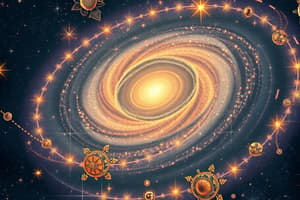Podcast
Questions and Answers
How many stars are in a galaxy?
How many stars are in a galaxy?
billions
Who set up a system to classify galaxies?
Who set up a system to classify galaxies?
Edwin Hubble invented a classification of galaxies and grouped them into four classes: spirals, barred spirals, ellipticals, and irregulars.
What are the three basic categories of galaxies?
What are the three basic categories of galaxies?
Elliptical, spiral, and irregular.
What would be the difference between a '0' elliptical galaxy and a '7' elliptical galaxy?
What would be the difference between a '0' elliptical galaxy and a '7' elliptical galaxy?
Which type of spiral galaxy is our Milky Way galaxy?
Which type of spiral galaxy is our Milky Way galaxy?
How big is the Milky Way galaxy?
How big is the Milky Way galaxy?
What are the most plentiful galaxies in the universe?
What are the most plentiful galaxies in the universe?
Elliptical galaxies contain mostly?
Elliptical galaxies contain mostly?
Why don't elliptical galaxies make new stars?
Why don't elliptical galaxies make new stars?
Flashcards are hidden until you start studying
Study Notes
Galaxy Characteristics
- Galaxies can contain billions of stars.
- The Milky Way, our galaxy, is a large barred spiral galaxy with an approximate diameter of 100,000 light-years.
Hubble's Classification System
- Edwin Hubble developed a classification system for galaxies, dividing them into four main types:
- Spiral
- Barred spiral
- Elliptical
- Irregular
Types of Galaxies
- Three basic categories of galaxies based on shape:
- Elliptical galaxies: Smooth and featureless, lacking structure.
- Spiral galaxies: Recognizable by swirling arms.
- Irregular galaxies: Do not fit into the other categories.
Elliptical Galaxies
- They are the most plentiful type in the universe but are often dimmer and older than other galaxies, making them less noticeable.
- Elliptical galaxies primarily contain Population II stars and tend to appear red.
- They do not form new stars actively due to a lack of gas and dust, which limits star formation.
Differences in Elliptical Galaxies
- Elliptical galaxies range from “0” to “7” in Hubble's classification, where “0” represents a more circular shape and “7” indicates a more elongated, flattened shape.
Star Formation
- Unlike spiral galaxies, which are rich in gas and dust and serve as hotbeds for star formation, elliptical galaxies do not produce new stars at a significant rate.
Studying That Suits You
Use AI to generate personalized quizzes and flashcards to suit your learning preferences.




